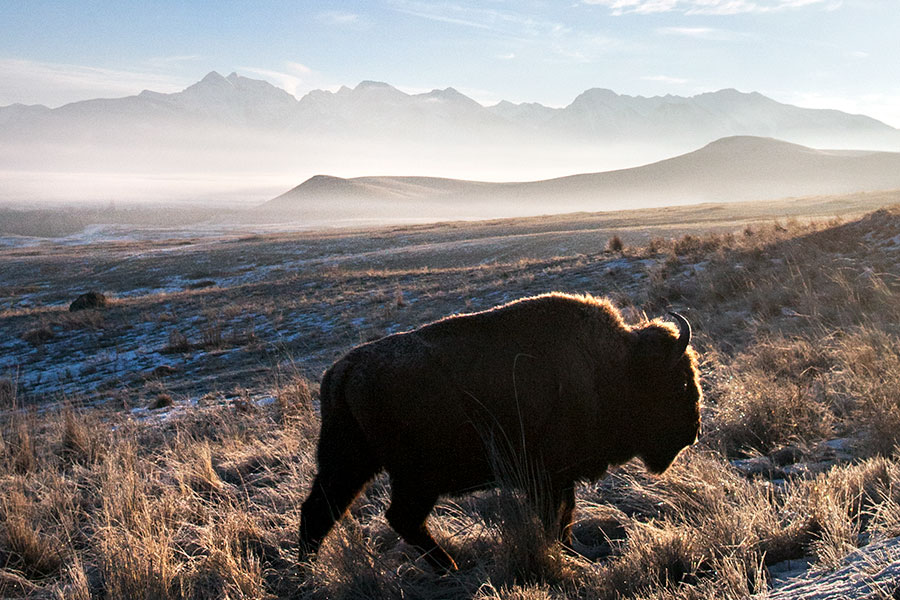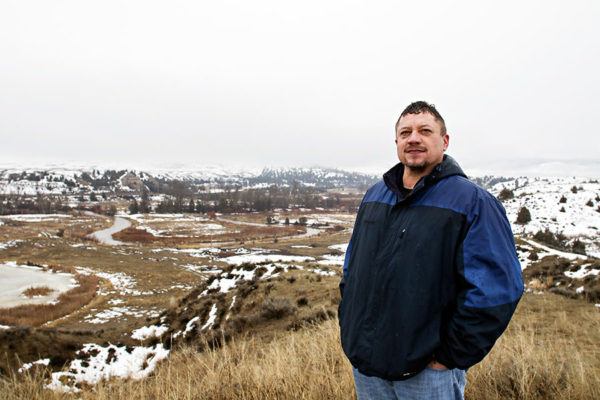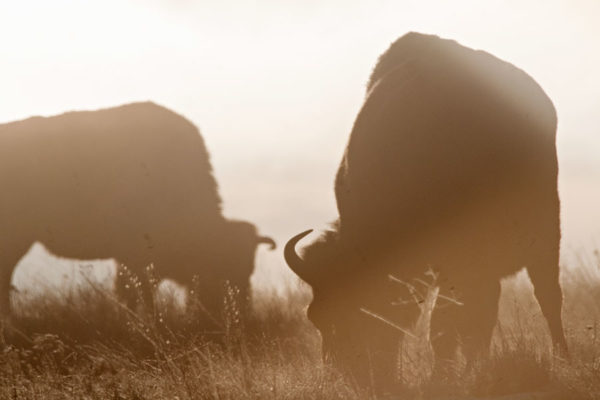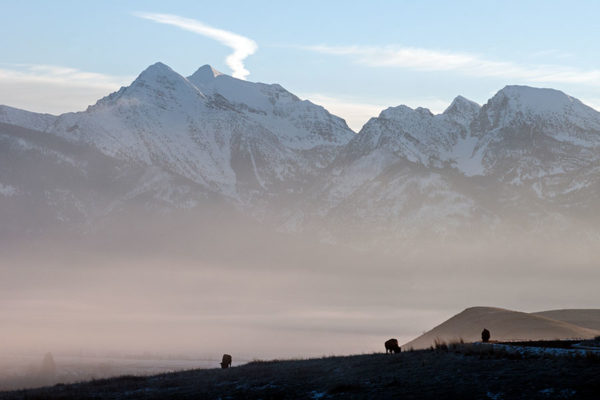The Way of the Buffalo
Boasting a model record of natural resource management and conservation, the Salish and Kootenai have been attempting to restore the National Bison Range to tribal ownership for 25 years
By Tristan Scott
There’s a prominent bluff-top perch on the Flathead Indian Reservation overlooking a 1,000-acre wetland that’s pocked with pothole pools and cut with the winding, trout-laden oxbow of Mission Creek, its banks bristling with native bull rushes, prairie grasses and cottonwoods.
Today these wetlands serve as a sponge-like habitat that filters and scrubs the watershed, which is home to trumpeter swans, pheasants, peregrine falcons, and native fish. But 15 years ago the view was tarnished with a collapsing railroad embankment, a pair of failing irrigation waste ditches and multiple generations’ worth of over-grazed ecological blight.
The dramatic before-and-after contrast, explains Rich Janssen, is the result of more than a decade of restoration work by the Confederated Salish and Kootenai Tribes (CSKT), which manages and conserves a diverse suite of wildlife species and ecological habitat on their 1.25 million-acre reservation. Through the tribes’ Natural Resource Department that Janssen runs, biologists have worked to restore and protect habitat that supports everything from grizzly bears and bighorn sheep to leopard frogs and cattails.
In terms of conservation success stories, Mission Creek is a big one, and Janssen is visibly proud of the work his team has accomplished, which includes efforts to protect and restore more than 400,000 additional acres of land on the Flathead Indian Reservation.
The stark historical contrast of the view, however, is remarkable for another, less-perceptible reason, which Janssen describes on a recent rainy morning as he shifts his gaze toward the fog-enshrouded foothills that rise just above the wetlands — those rolling features in the near distance are part of the National Bison Range, a federally owned parcel that supports several hundred head of bison and is managed by the U.S. Fish and Wildlife Service (FWS) as a National Wildlife Refuge.
An angler casting a fly on the Flathead Indian Reservation’s Mission Creek might be inclined to ply the water upstream, and he would in turn be surprised to find out that water is flowing through the National Bison Range’s Mission Creek. It’s the same watershed supporting the same suite of species, but it’s bisected by some complicated jurisdictional nuances.

Rusty Sydnor, a biologist with CSKT, explains how the restoration project helps clean up the refuse from irrigation canals that can deliver fertilizer-laced runoff from farming fields.
“These wetlands that you see down below us we have actually constructed over the past 10 years to help clean up the water,” he said. “The hills in the background form the National Bison Range, and Mission Creek flows directly out of there. So we are managing over 1,000 acres right next door to the National Bison Range. We are protecting fisheries habitat, wildlife habitat, and we are doing our best to restore that habitat. We have very similar goals and vision as to the National Bison Range.”
Indeed, there’s not much of an ecological disparity between the tribes’ wetland restoration project and the federal government’s bison range, and the management goals of the two entities mesh more often than they don’t.
The political gulf, on the other hand, is as wide as the Mission Valley, and it stretches back more than a century.
For the past 25 years, the tribes have been actively seeking to restore ownership of the National Bison Range to a federal trust, which would allow the Salish and Kootenai to assume — or resume — full management responsibilities of the range.
And just in case the juxtaposition of the tribes’ wetland restoration project on Mission Creek and the federal authority over the bison range isn’t sinking in, Janssen makes his point even clearer.
“We are the top tribe in the nation for managing natural resources. We led the restoration efforts to bring this land back to its natural state. Its water had been diverted and contaminated. It had been grazed down to the dirt. These banks were eroded,” he says from the bluff. “Now there are migratory birds, amphibians, fish, and other wildlife species. It’s a success.”
“You can see the National Bison Range from here, and we’re not leading that conservation conversation,” he said. “We’re not allowed to, even though the bison wouldn’t be here if it weren’t for us.”

In 1908, the tribes ceded control of the land against their will when the government established the National Bison Range in the Mission Valley, an 18,766-acre postage stamp of federal land right in the middle of the Flathead Indian Reservation. Returning management authority to the tribes — which would require legislative action — has long been a goal of the Confederated Salish and Kootenai Tribes (CSKT), but negotiations have been stalled for 25 years.
But the connection between the Salish and Kootenai to the bison runs much deeper, though it’s a narrative that tribal leaders say has been disrupted. That disruption prompted CSKT to commission a recent documentary about their cultural connection to the bison, called “In the Spirit of Atatice: The Untold Story of the National Bison Range.”
In the film, tribal elders explain how they were responsible for bringing the first buffalo herd to the Flathead Indian Reservation at a time when the animals were at risk of extinction, literally driving a small herd of bison calves across the Continental Divide in the 1870s. Descendants of those buffalo formed the vast majority of the National Bison Range’s original herd.
The idea to revive the bison population dates back even further still, when a Pend d’Oreille Indian named Atatice, or Peregrine Falcon Robe, raised the issue with several chiefs who ultimately decided it wasn’t the right time. Later on, his son, Latati, or Little Falcon Robe, decided to realize his father’s vision while he was on a buffalo hunt on the east side of the mountains.
“To bring those animals over that distance across the Continental Divide is a huge effort,” Whisper Camel Means, a tribal biologist, said.

In 1884, Latati’s step-father sold the herd to Charles Allard and Michel Pablo without Latati’s consent, and the Allard-Pablo herd continued to grow until the 1904 allotment of reservation lands to non-Indian homesteaders, which devastated the tribes socially and economically. With the construction of fences, Pablo was forced by the federal government to sell the free-ranging herd, much of which went to Charles E. Conrad in Kalispell.
When the American Bison Society began scouting land to establish a bison range, the organization contracted with the ecologist Morton J. Elrod, a professor at the University of Montana who founded the Flathead Lake Biological Station in 1899.
Elrod suggested the Flathead Indian Reservation and, against the will of the tribes, the National Bison Range was established in 1908, with 36 bison from the Conrad family serving as the initial herd. Establishment of the Bison Range fragmented the reservation further, and the Salish term for the range translates as “fenced-in place.”
“It was a taking,” CSKT Tribal Chairman Ron Trahan said. “It was just like a homestead. Whether or not you liked it, they were going to take it.”
That history, in combination with the range’s location in the center of the Flathead Indian Reservation, adds resonance to the idea of restoring the range to federal trust ownership for the tribes, leaders say.
Back on the bluff overlooking Mission Creek, Janssen said the tribes have a strong record of conservation and natural resource management.
“When the tribes have taken on big projects, whether it was assuming operation of the electric utility that serves the entire reservation, or helping to design a wildlife-friendly highway renovation unlike any other in the country, we take them seriously,” Janssen said. “We work to get the job done, and get it done well. The Bison Range would be no different. We already have an extensive network of tribally designated conservation areas that surround the Bison Range; its central location would be a logical addition to tribal lands and would promote more holistic management.”

Keith Aune, Bison Program Director for the Wildlife Conservation Society, has been a vocal supporter of CSKT’s efforts to restore management of the National Bison Range to a federal trust ownership, and says their record on the conservation of natural resources sets a high bar.
“What’s great about the Confederated Salish and Kootenai Tribes is that they have become a model of how you practice conservation on tribal lands not only within the boundaries of the reservation but even beyond,” Aune said.
One of the tribes’ most important wildlife projects helps offset damage to thousands of acres of tribal wetlands and other wildlife habitat caused when Kerr Dam was built on the Flathead River in the 1930s. Using mitigation funding the tribes negotiated from the dam’s corporate owner and the Federal Energy Regulatory Commission, the wildlife program has spearheaded the acquisition of more than 11,000 acres of wetland and riparian habitat on the reservation owned by nontribal members.
According to Dale Becker, who runs CSKT’s Tribal Wildlife Management Program, the restoration of those ecologically rich habitats, many damaged by drainage, tillage and overgrazing, is ongoing, and complements additional wetlands acquired and restored by Montana Fish, Wildlife and Parks and the FWS, forming a wetlands complex in the Mission Valley involving state, federal and tribal agencies.
“There is a cooperative effort with FWS, FWP and the tribes,” Becker said. “We may have different individual management goals, but with regard to the species that inhabit those areas we all have the overall goal of managing to benefit wildlife and its habitat. These animals don’t know political boundaries.”
It’s a degree of cooperation that also exists on the National Bison Range, but CSKT’s interest in assuming management responsibilities on the land and the bison remains strong.
Since 1994, tribal leaders have pursued both transfers and joint management arrangements with the U.S. Department of the Interior, which oversees the FWS. Every effort has met various stumbling blocks, and the past two decades have been replete with lawsuits, accusations of mismanagement by both CSKT and the Fish and Wildlife Service, and even racism.
“It’s easy for the public to get the idea of the monolithic Indian,” Robert McDonald, a spokesman for the tribe, said, noting that public comments on the proposals have included racially charged epithets. “But we have never let go of the historic cultural and geographic connection to this land and the bison.”
In 2016, the CSKT released a draft proposal that would place the range back into federal trust ownership for the tribes, which tribal leaders said includes management for bison conservation purposes as well as continued public access and was supported by the FWS.
Those discussions were derailed in 2016 when the group Public Employees for Environmental Responsibility (PEER), which has adamantly opposed tribal involvement at the Bison Range, filed a lawsuit against the U.S. Fish and Wildlife Service, arguing that the federal agency failed to conduct the necessary environmental review before telling CSKT that it would support legislation to transfer the wildlife refuge to the tribes.
The group said the agency’s proposed partnership with CSKT would set a dangerous precedent, and could spark demands by other tribes for similar handovers at 18 other U.S. national wildlife refuges and 57 national parks.
Last year, PEER settled its lawsuit under the agreement that the agency would prepare a Comprehensive Conservation Plan for the refuge, a process that an agency spokesperson said is still underway.
On March 20, however, CSKT leaders announced they “would like to revisit the proposal to restore the National Bison Range to federal trust ownership for the benefit of the tribes. This was the status of the Bison Range lands under the Hellgate Treaty, prior to the creation of the Range.”
Restoration of that ownership has gained prominent support from more than 20 conservation organizations, tribal councils and individuals, ranging from the Sierra Club to the Indigo Girls.

In 2003, the New York Times editorial board supported CSKT’s efforts for tribal management at the National Bison Range, recognizing the singular circumstances.
“Virtually no one disputes the excellent management and conservation record of the Salish and Kootenai,” the editorial stated. “The National Bison Range is an unusual case. It offers a rare convergence of public and tribal interests. If the Salish and Kootenai can reach an agreement with the Fish and Wildlife Service, something will not have been taken from the public. Something will have been added to it.”
The Bison Range’s future still isn’t settled as the FWS prepares a new comprehensive conservation plan for the refuge while the public wonders what a tribally managed bison range would look like.
According to CSKT attorney Brian Upton, it would look pretty much the same as it does now.
“Management of the range or the bison really wouldn’t change if it was restored to federal trust ownership,” Upton said. “One example of a change that might be visible to the public is the visitor’s center. Right now it’s not a reflection of the region’s tribal heritage, and we believe a lot of people would find that a very enriching interpretive experience.”
Becker echoed those sentiments, and said the U.S. Fish and Wildlife Service has done a commendable job managing the herd and the National Bison Range.
“We have a great working relationship with our colleagues in the state and federal agencies,” Becker said. “We have a great working relationship with the Fish and Wildlife Service. We all realize the different skillsets and perspectives that other folks bring to the table and how that benefits the species. It just works.”
Taking one last glance over the expanse of wetlands surrounding Mission Creek, Janssen sums up the tribes’ commitment to being stewards of the local region and the wildlife it supports.
“We are only here for a short period of time,” Janssen said. “We need to take care of it. This is our home.”